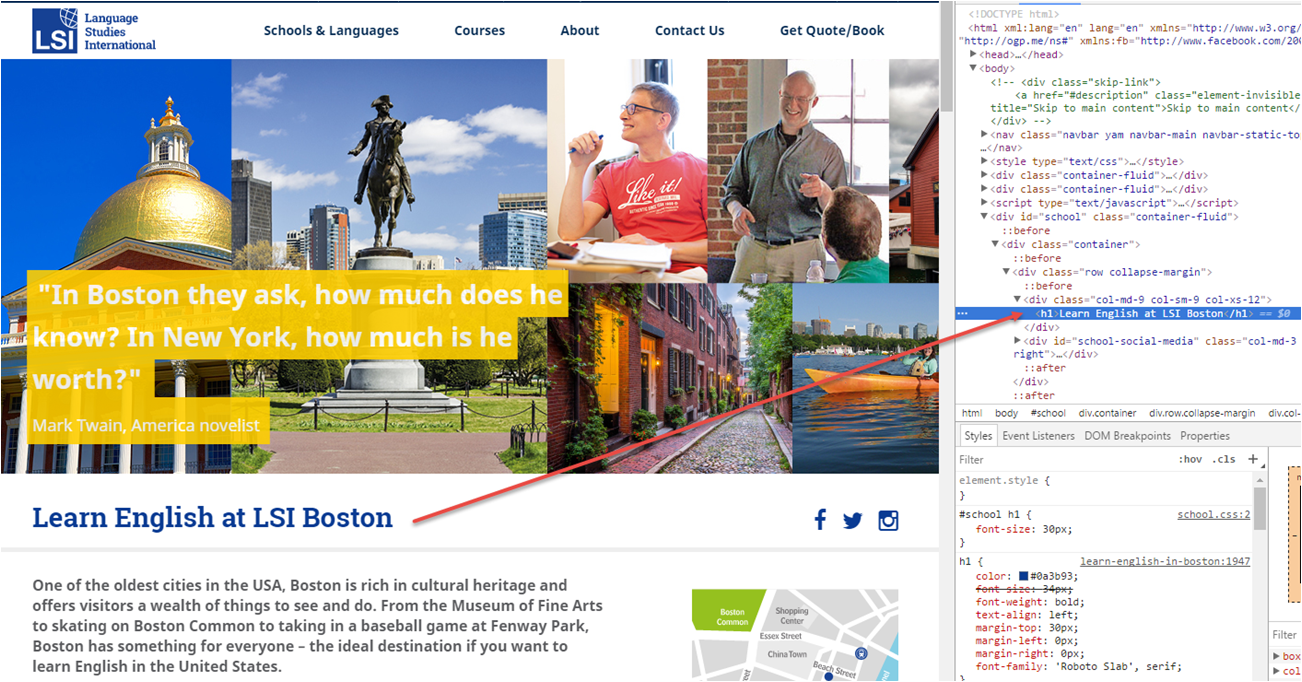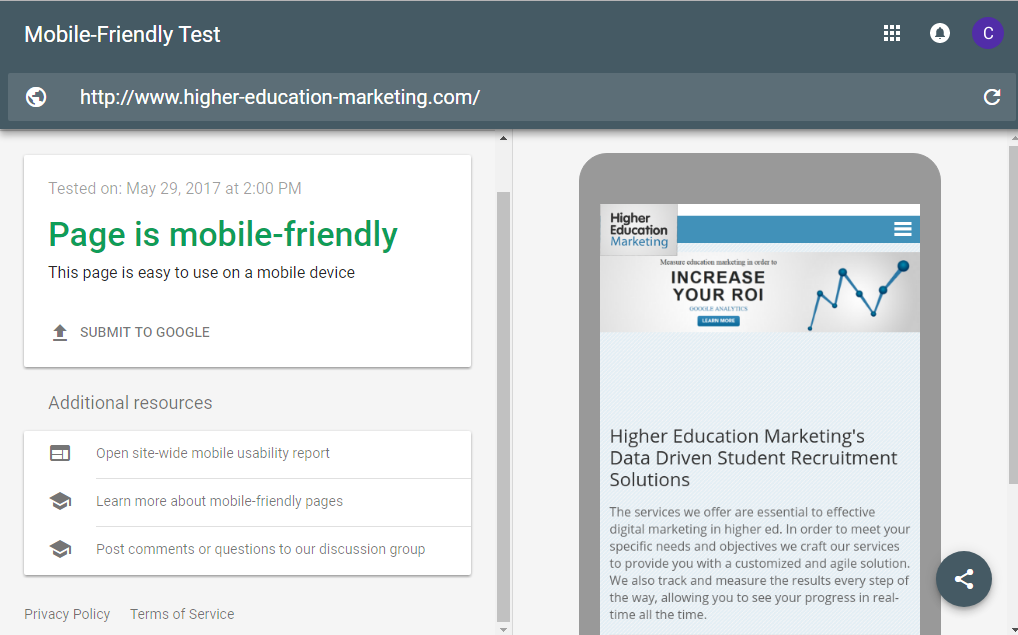
In a competitive area like student recruitment, the quality of your SEO strategy can be the difference between success and failure. No matter how good your programs, web content, and recruitment operations are, failing to fully optimize your online activities can severely limit your chances of reaching and engaging with prospective students.
With that in mind, checking the health of your SEO regularly can be crucial, ensuring that your site adheres to the most up-to-date best practices in the area and is optimally structured to help both web users and search engines like Google to easily find your school online.
While an in-depth SEO evaluation can require a lot of time and expertise, you can easily perform a few quick and simple exercises to audit your current activities even if you have little knowledge of the area. Here’s how to do it.
1. Education Marketing On-Page SEO Basics: Titles, URLs & Meta Descriptions
While a range of complex factors can influence search engine rankings, some of the most important are also some of the simplest. Page titles, for instance, send a strong message about their purpose and relevance to search engines, and can heavily influence what searches they show up in.
You should take care to ensure that each of your pages has a unique title which accurately describes what it offers. Ideally, page titles should be under 70 characters long to avoid them being truncated in search results. They should also contain a relevant keyword, if possible.
However, these are only guidelines, and shouldn’t be incorporated at the expense of the clarity and quality of your titles. Above all else, well-written, relevant titles are what will really attract more prospective students to your site, so this should be your priority.
Example: From this search for language schools in Dublin, Ireland, you can see that many institutions have incorporated relevant keywords into their home page titles.

URLs are also a minor ranking factor for SEO, and you should try to ensure that yours are clean, incorporate relevant key search terms, and don’t contain any unusual characters, where possible. This will make them easier for both web users and search engines to understand.
In addition, while they don’t necessarily factor into your search rankings, meta descriptions can also be vitally important when it comes to increasing the amount of clicks you get on your site. A meta description is the brief snippet of text that appears underneath the title and URLs in search results, and should generally be somewhere between 135 to 160 characters.
For schools, meta descriptions provide an opportunity to tell prospective students a little more about the page they are about to view, and a well-written and enticing meta description can make all the difference regarding the amount of engagement a page generates. Again, you should be aiming to include a relevant keyword where possible, and try to include some extra information that is not contained in your page title.
Example: The University of Southampton’s homepage meta description includes two of the school’s unique selling points, focusing on its global ranking and membership of the prestigious Russell Group.

While they may seem like minor factors, getting each of these simple elements right can go a long way to improving your rankings, making them an excellent starting point for enhancing your education marketing SEO.
2. Maximizing Your School’s On-Page SEO Potential: Header Tags & Keyword Integration
Once you have examined the titles, URLs, and meta descriptions of your pages, it’s time to look at other elements of your online content. You will want to ensure that all pages on your site make proper use of header tags, which are HTML tags that denote the main title and other headings on your page.
There are six levels of header tags—from H1 to H6—with H1 being the primary indicator to search engines of what the page is about, while the other tags are used to denote subheadings of lesser importance on the page. Generally, it is best practice to have just one H1 per page (usually the title), and then a series of H2s for different sections or paragraphs. Lower level header tags may be necessary for longer pages with multiple subsections.
Example: Language Studies International, an ESL Provider in Boston, uses an H1 tag on the title of its web page, which also contains relevant key search terms.

Header tags make it easier for search engine crawlers to understand the structure of your pages, and making sure relevant keywords are integrated into them can significantly boost your SEO efforts.
Keywords can also be integrated throughout your text, but only where they fit naturally. Modern search engine algorithms tend to penalize pages that appear to be forcing as many key terms as possible into their pages, which is known as ‘keyword stuffing.’
Using Google Analytics to see where your site ranks for certain key queries will help you to determine whether you need to make improvements in this area, and you can also use tools like Alexa and Simply Measured to analyze your competitors’ rankings and see how your school compares.
3. Check Your School’s Website Structure and Indexability
While manually checking certain elements of your site can be beneficial, one of the most effective and efficient ways of boosting SEO for education marketing is to perform a site crawl. This involves having a software program crawl you site in the same way that the crawlers of search engines like Google and Bing would, in order to evaluate the architecture and indexability of your pages. There are a number of affordable tools available online to do this, such as Beam Me Up and Screaming Frog’s SEO Spider tool.
You can see how Screaming Frog’s program works in the video below:

Performing an SEO crawl will allow you to identify a number of potential problems with your site, such as:
- Broken links
- Duplicate content
- Redirect errors
- Identifying long, short, or duplicated titles and meta descriptions
- Identifying issues with your robot.txt files, which instruct crawlers on how to index your site
Each of these issues make your site harder for search engines to understand, and can negatively impact your SEO. Many crawling software tools can also be used to create a sitemap for your website, which is a hierarchical list of all your pages that is used by search engine crawlers in indexing. Making sure that your sitemap is up-to-date and contains no errors can be vital to your overall SEO health.
You can also find a number of other handy tools that will help you gain insights into the functionality of your pages in Google’s search console, including crawl errors, crawl stats, and a robots.txt tester:

You can also access the Fetch as Google tool, which allows you to see your website the way Google’s search engine crawlers see it:

Another crucial thing that site owners can neglect to check when evaluating indexability and architecture is whether multiple versions of their site are being indexed by search engines, particularly if they have recently switched from a http site to a https site. As pointed out in this excellent Ahrefs article, this can lead to multiple versions of your site existing:
- http://yourdomain.com
- http://www.yourdomain.com
- https://yourdomain.com
- https://www.yourdomain.com
If search engines like Google are crawling all of these addresses, it can weaken your page authority and lead to problems with duplicate content. You can prevent this by setting one of these addresses as your primary domain in Google’s search console.
4. Evaluating Website Functionality to Improve Your Education Marketing SEO
Mobile-friendliness has become a huge part of SEO in recent years. Ever since Google’s infamous ‘Mobilegeddon’ update in 2015, search engines have been heavily favouring sites which are optimized for mobile users, with an additional mobile-friendly update by Google in late 2016 further increasing its importance as a ranking factor.
While having a proper responsive design on your site should ensure that your school doesn’t incur penalties, checking for errors or issues every now and then can still be helpful. Common mistakes can include faulty redirects—such as internal links for a desktop page of your site in the mobile version—or video content that plays on formats which aren’t widely supported by many smartphones, such as Flash.
You can use Google’s mobile friendly test page in Webmaster Tools to get a quick diagnosis of your site:

However, manually browsing your site can also be a good idea in order to evaluate the full mobile user experience. You may find certain issues that the mobile-friendly test doesn’t pick up on, such as problems with text size or the placement of certain elements on your pages.
Another factor which is important not to overlook is your page load times. Not only is page speed used as a ranking signal by most search engines, but a site which takes too long to fire up can seriously affect user experience and discourage engagement.
This can be especially important when you are looking to recruit international students, as internet speed can vary widely between different countries, meaning that a site which loads quickly in your location may not be as fast where your target audience is based. You can see the extent of the disparity in internet speed between different nations in the table below:

Loading times can be a particular problem in SEO for education websites, with many schools performing lower than average in this area. You can see how your site measures up by testing it using Google’s PageSpeed Insights or other tools like Pingdom, both of which provide a full breakdown of a page’s performance, as well as a number of helpful suggestions for optimizing your load times.
You could also consider creating accelerated mobile page (AMP) versions of your site’s content. AMP is an open-source project Google has initiated to create mobile versions of pages that load faster, and pages that have adopted the format tend to rank highly in searches. Popular content management system (CMS) platforms like WordPress now provide plug-ins which can help you generate these pages automatically.
5. Content Quality is Still the Top Priority for Education Marketing SEO
While the technical side of your website’s SEO is important, your content is what will ultimately ensure that you rank highly in search results. Schools need to be mindful of the type of web content that search engines favour, ensuring their pages have a good text to code ratio, and incorporate plenty of visual content such as photos and videos. You can use alt tags on images to help search engines read them more easily, while schools can optimize video content using metadata such as VideoObject tags and video site maps.
However, it’s important not to prioritize SEO-friendliness over quality and relevance. SEO best practices are meant to enhance content, not detract from it, and you should be cautious about sacrificing useful information or comprehensibility for the sake of a quick rankings boost. Search engine algorithms are getting smarter all the time, and once your site delivers the content that prospective students want and need, it is bound to rank well.
Nonetheless, evaluating your site in each of these areas from time to time can be a great way to ensure your overall strategy stays on track. While some are more time consuming than others, you can make it more manageable by choosing to check a few pages at a time, or focus on areas of your site where you are not getting as much hits as you would expect. Often, you will find that the problems are easily fixed, and can give an instant and valuable boost to your school’s lead generation efforts.






